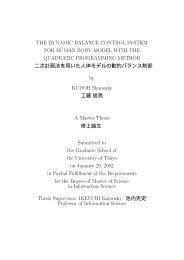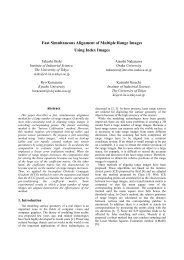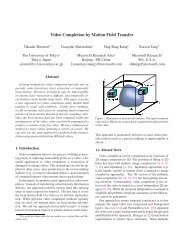A Method for Fine Registration of Multiple View Range Images ...
A Method for Fine Registration of Multiple View Range Images ...
A Method for Fine Registration of Multiple View Range Images ...
You also want an ePaper? Increase the reach of your titles
YUMPU automatically turns print PDFs into web optimized ePapers that Google loves.
Computer Vision and Image Understanding 87, 66–77 (2002)<br />
doi:10.1006/cviu.2002.0983<br />
A <strong>Method</strong> <strong>for</strong> <strong>Fine</strong> <strong>Registration</strong> <strong>of</strong> <strong>Multiple</strong> <strong>View</strong><br />
<strong>Range</strong> <strong>Images</strong> Considering the Measurement<br />
Error Properties<br />
Ikuko Shimizu Okatani<br />
Department <strong>of</strong> In<strong>for</strong>mation and Computer Sciences, Saitama University Shimo-Okubo 255,<br />
Saitama, 338-8570, Japan<br />
E-mail: ikuko@cda.ics.saitama-u.ac.jp<br />
and<br />
Koichiro Deguchi<br />
Graduate School <strong>of</strong> In<strong>for</strong>mation Sciences, Tohoku University Aoba-Campus01, Sendai, 980-8579, Japan<br />
E-mail: kodeg@fractal.is.tohoku.ac.jp<br />
Received August 31, 2001; accepted September 6, 2002<br />
This paper presents a new method <strong>for</strong> fine registration <strong>of</strong> two range images from<br />
different viewpoints that have been roughly registered. Our method deals with the<br />
properties <strong>of</strong> the measurement error <strong>of</strong> the range image data. The error distribution<br />
is different <strong>for</strong> each point in the image and is usually dependent on both the viewing<br />
direction and the distance to the object surface. We find the best trans<strong>for</strong>mation<br />
<strong>of</strong> two range images to align each measured point and reconstruct 3D total object<br />
shape by taking such properties <strong>of</strong> the measurement error into account. The position<br />
<strong>of</strong> each measured point is corrected according to the variance and the extent <strong>of</strong><br />
the distribution <strong>of</strong> its measurement error. The best trans<strong>for</strong>mation is selected by<br />
the evaluation <strong>of</strong> the effectiveness <strong>of</strong> this correction <strong>of</strong> every measured point. The<br />
experiments showed that our method produced better results than the conventional<br />
ICP method. c○ 2002 Elsevier Science (USA)<br />
Key Words: range image; registration; multiple views; measurement error.<br />
1. INTRODUCTION<br />
This paper proposes a method <strong>for</strong> fine registration <strong>of</strong> range images obtained from several<br />
different viewpoints to reconstruct the total object shape. Each range image data is represented<br />
in an individual 3D coordinate system that depends on the position and the orientation<br />
<strong>of</strong> the range finder. Hence, to integrate them, the trans<strong>for</strong>mations <strong>of</strong> the coordinate systems<br />
1077-3142/02 $35.00<br />
c○ 2002 Elsevier Science (USA)<br />
All rights reserved.<br />
66
FINE REGISTRATION OF MULTIPLE VIEW RANGE IMAGES 67<br />
must be estimated correctly. Many methods <strong>for</strong> 3D reconstruction by integrating registered<br />
range images have been proposed [1–3]. To reconstruct a reliable model <strong>of</strong> the object, an<br />
algorithm considering the measurement error <strong>of</strong> the range image data was proposed [3].<br />
However, there are some difficulties in fine registration <strong>of</strong> range images. First, range<br />
images are given as sets <strong>of</strong> discrete points, and different sets <strong>of</strong> range images obtained<br />
from different viewpoints do not usually include a common object point. Second, some<br />
areas <strong>of</strong> an object surface observed from one viewpoint are not observed from the other<br />
viewpoints because <strong>of</strong> the occlusion. Be<strong>for</strong>e the registration has been done, we cannot know<br />
which areas are commonly observed. Furthermore, they contain measurement error whose<br />
properties depend on both the relative orientation <strong>of</strong> the surface to the viewing direction<br />
and the distance from the surface to the viewpoint; that is, the properties <strong>of</strong> measurement<br />
error are different <strong>for</strong> each point.<br />
Several registration methods attempting to overcome these difficulties have been proposed<br />
in the literature. In those methods, first, rough registration was carried out by selecting<br />
some feature points and establishing their correspondences between multiple views [4, 5].<br />
Next, the iterative closest point (ICP) method proposed by Besl [6] was applied <strong>for</strong> fine<br />
registration. Almost all <strong>of</strong> the subsequent methods <strong>for</strong> fine registration have been based<br />
on and extensions <strong>of</strong> the ICP method. In the ICP method, a point set is registered to<br />
another point set by minimizing the sum <strong>of</strong> squared Euclidean distances from each point<br />
in the first set to the nearest point in the second set. However, the nearest pairs are not<br />
necessarily the true corresponding ones. This limited the per<strong>for</strong>mance <strong>of</strong> the original ICP<br />
method. To maintain correspondences, Zhang [7] excluded the corresponding pair whose<br />
distance is larger than a threshold. Chen [8] and Dorai [9] used only smooth surface parts<br />
to register the point sets and minimized the sum <strong>of</strong> distances between each point in one<br />
image to a tangential plane made from points in another image. Turk [10] represented<br />
range images as a set <strong>of</strong> triangular patches and eliminated corresponding pairs <strong>of</strong> which<br />
either is on the surface boundary. Masuda [11] employed a robust estimation technique<br />
also to avoid false correspondences. Bergevin [12] proposed simultaneous registering <strong>of</strong><br />
multiple range images to avoid the accumulation <strong>of</strong> the errors in the sequential estimation<br />
<strong>of</strong> trans<strong>for</strong>mations. But, those methods did not achieve fine registration because they did<br />
not consider the characteristic properties <strong>of</strong> the measurement error.<br />
Generally, the measurement errors <strong>of</strong> distant points and points on a steep surface with<br />
respect to the viewing direction become larger, as shown in Fig. 1. In addition, the measurement<br />
error in the viewing direction is much larger than those in the directions parallel to<br />
the image plane. There<strong>for</strong>e, to achieve a fine registration, we must take into account these<br />
FIG. 1.<br />
Distributions <strong>of</strong> measurement errors in range images.
68 OKATANI AND DEGUCHI<br />
error properties, while the conventional methods based on the ICP method considered these<br />
errors to be isotropic and uni<strong>for</strong>m at every point.<br />
In our method, one <strong>of</strong> the range images will be represented as a set <strong>of</strong> triangular patches,<br />
and the other as a set <strong>of</strong> points. We estimate the most probable trans<strong>for</strong>mation <strong>of</strong> the second<br />
image to overlay it onto the first image considering the measurement error distributions.<br />
For a given trans<strong>for</strong>mation, the positions <strong>of</strong> every measured point both in the two range<br />
images are corrected according to the individual variance <strong>of</strong> its measurement error. The<br />
amount and the direction <strong>of</strong> the correction depend on the extent <strong>of</strong> the measurement error<br />
distribution which is expressed the error variance. Then, the best trans<strong>for</strong>mation is selected<br />
by the evaluation <strong>of</strong> the facility <strong>of</strong> this correction <strong>of</strong> all measured points.<br />
To establish the best registration by this new approach, the problem still remains that we<br />
do not know which point in the second image must lie on which triangular patch in the first<br />
image. The true trans<strong>for</strong>mation can be estimated after proper correspondences <strong>of</strong> points and<br />
patches have been established. For this problem, we employ an alternative iteration <strong>of</strong> the<br />
estimations <strong>of</strong> the trans<strong>for</strong>mation and the correspondences.<br />
In Section 2, we discuss on the properties <strong>of</strong> the measurement error <strong>of</strong> the range image.<br />
Then, we propose a fine registration algorithm in Section 3. Experimental results are shown<br />
in Section 4.<br />
2. MEASUREMENT ERROR IN RANGE FINDING<br />
A range image obtained by a range finder is represented in the coordinate system depending<br />
on the position and the orientation <strong>of</strong> the range finder. We denote each coordinate system<br />
with the x- and y-axes being within the image plane and the z-axis in the viewing direction.<br />
For a measurement x = (x, y, z) ⊤ <strong>of</strong> an object point, we assume that its measurement error<br />
x − ¯x with respect to the true value ¯x is the normal distribution with an expectation <strong>of</strong> 0<br />
and the covariance matrix V [ ¯x].<br />
Among the factors which cause the measurement error, the image quantization error is<br />
principal. Generally, as is in stereo, the positional error in the viewing direction which is<br />
caused by the image quantization will be proportional to the square <strong>of</strong> the distance, while the<br />
error in parallel directions to the image plane will be linearly proportional to the distance [13]<br />
so that the positional error in the z direction is considered to be dominant and the errors in the<br />
x and y directions can be neglected in registration. Hence, we approximate V [x] as having<br />
the <strong>for</strong>m V [x] = ( 0 0 0 0 0<br />
0). This approximation assumes that the distribution <strong>of</strong> the measurement<br />
z <strong>of</strong> the point whose true distance is ¯z is expressed by the probability density<br />
2 0 0 σ<br />
function<br />
[<br />
1<br />
p(z|¯z) = √ exp − 1 ( ) ]<br />
¯z − z<br />
2<br />
, (1)<br />
2πσ<br />
2 2 σ<br />
and the measurements <strong>of</strong> x and y are considered to be true values. The standard deviation<br />
σ <strong>of</strong> the measurement error depends on the distance to the object point and the steepness<br />
<strong>of</strong> the object surface around the point with respect to the viewing direction.<br />
It should be noted that, as shown in Fig. 1, the dominant directions <strong>of</strong> the error distributions<br />
are different according to the viewing directions. Although the error model is still kept simple<br />
by allowing only errors in the z direction, the correction <strong>for</strong> fine registration becomes rather<br />
complicated, but it will be worthwhile applying to obtain the dramatically improved results<br />
shown in the experiments.
FINE REGISTRATION OF MULTIPLE VIEW RANGE IMAGES 69<br />
For every measurement x, we denote its estimation <strong>of</strong> the z coordinate by ẑ. That is,<br />
ˆx = (x, y, ẑ) ⊤ .<br />
3. REGISTRATION OF TWO RANGE IMAGES<br />
3.1. Relation between the Coordinate Systems<br />
Let us denote the 3D coordinates <strong>of</strong> the mth point in the first range image by x m 1 , and the<br />
kth point in the second range image in its own coordinate system by x k 2 . The coordinates xk 2 <strong>of</strong><br />
the second range image will be represented in the first coordinate system by a trans<strong>for</strong>mation<br />
T consisting <strong>of</strong> a rotation matrix R and a translation vector t as T (x k 2 ) = Rxk 2 + t. Then,<br />
the registration is to determine the true R and t, and, at the same time, obtain the total 3D<br />
point set free from measurement error.<br />
3.2. Estimation <strong>of</strong> the Trans<strong>for</strong>mation<br />
We assume that the object consists <strong>of</strong> a set <strong>of</strong> almost smooth surface segments and that the<br />
surface segments commonly viewed from both viewpoints have sufficiently dense measured<br />
points. Then, each segment can be represented as a set <strong>of</strong> triangular patches. If a point in<br />
one image does not lie on its corresponding triangular patch in the other image even when<br />
the true trans<strong>for</strong>mation is given, it is caused by measurement error in the range finding. In<br />
this sense, we find the most probable correspondences <strong>of</strong> points and patches considering<br />
the above-mentioned properties <strong>of</strong> measurement error. Of course, by occlusions etc., some<br />
<strong>of</strong> the points in one range image have no correspondence in the other image. These points<br />
must be properly excluded in the estimation process <strong>of</strong> the trans<strong>for</strong>mation described in<br />
Section 3.3.<br />
In our method, the first range image is represented as a set <strong>of</strong> triangular patches {△ m 1 }<br />
and the second range image is represented as a set <strong>of</strong> points {x k 2 }. As shown in Fig. 2,<br />
we assume that the kth point in the second image corresponds to the n(k)th triangular<br />
patch △ n(k)<br />
1 ={x n(k) 1<br />
1 , x n(k) 2<br />
1 , x n(k) 3<br />
1 } in the first image; that is, x k 2 is a measurement <strong>of</strong> a point<br />
included within △ n(k)<br />
1 . If the trans<strong>for</strong>mation T is correct and the point T (ˆx k 2 ) does not lie on<br />
△ n(k)<br />
1 , as shown in Fig. 3, it is the result from their measurement errors. Hence, the positions<br />
<strong>of</strong> x k 2 and also xn(k) m<br />
1 (m = 1, 2, 3) should be corrected to lie on the same plane. The position<br />
<strong>of</strong> each point is corrected only in its viewing direction according to the amount <strong>of</strong> their<br />
FIG. 2.<br />
Correspondence <strong>of</strong> a point in the second range image and a triangular patch in the first range image.
70 OKATANI AND DEGUCHI<br />
FIG. 3. If the trans<strong>for</strong>mation is correct, a point in the second range image and the three vertices <strong>of</strong> its<br />
corresponding triangular patch in the first range image must lie on a plane.<br />
respective variances <strong>of</strong> the measurement errors. Thus, we obtain the estimations ˆx n(k) m<br />
1 and<br />
ˆx k 2 so that T (ˆxk 2 ) and ˆxn(k) m<br />
1 lie on the same plane. This implies that<br />
a k ˆx n(k) 1<br />
1 + b k ˆx n(k) 2<br />
1 + c k ˆx n(k) 3<br />
1 = T (ˆx k 2)<br />
, ak + b k + c k = 1, 0 ≤ a k , b k , c k ≤ 1. (2)<br />
We consider that the best trans<strong>for</strong>mation achieves this relation with the largest probability<br />
<strong>for</strong> both estimations ẑ1 m <strong>of</strong> zm 1 and ẑk 2 <strong>of</strong> zk 2 . Such a trans<strong>for</strong>mation will be obtained by<br />
minimizing the next log-likelihood function<br />
J = ∑ m<br />
1 (ẑm<br />
( )<br />
σ<br />
m 2 1 − z m ) 2<br />
∑ 1 (ẑk<br />
1 + ( )<br />
1 k σ<br />
k 2 2 − z k 2,<br />
2)<br />
(3)<br />
2<br />
under the constraint <strong>of</strong> (2), because the distribution <strong>of</strong> the measurement z is assumed to be<br />
expressed with the probability function <strong>of</strong> (1).<br />
In our strategy, first, we select T as described later and apply it to the points in the second<br />
image. Then, every point in the second image and the vertex points <strong>of</strong> its corresponding<br />
triangular patch in the first image are moved to lie on a plane, respectively, under the<br />
constraint that point positions can be corrected only in their respective viewing directions.<br />
Such a correction is not unique, but we select one which minimizes J <strong>of</strong> (3) <strong>for</strong> this<br />
trans<strong>for</strong>mation.<br />
At this time, we have the estimations ẑ1 m <strong>of</strong> zm 1 and ẑk 2 <strong>of</strong> zk 2 in J <strong>of</strong> (3), and we have<br />
the value <strong>of</strong> J <strong>for</strong> a given trans<strong>for</strong>mation T . Then, the trans<strong>for</strong>mation ˆT that gives the<br />
minimum value <strong>of</strong> J among all the possible T is considered to be the best estimation <strong>of</strong><br />
trans<strong>for</strong>mation, so that, in the next step, we modify T to reduce the value <strong>of</strong> J.<br />
We employ alternative iterations <strong>of</strong> the first estimation <strong>of</strong> the correspondence and the<br />
second estimation <strong>of</strong> the trans<strong>for</strong>mation. It should be noted that three vertex points <strong>of</strong> a<br />
triangular patch are also vertex points <strong>of</strong> their neighboring triangular patches. This implies<br />
that all triangular patches cannot be modified independently in the first step. It also should<br />
be noted that every correspondence <strong>of</strong> a point and a triangular patch cannot be known<br />
be<strong>for</strong>ehand.
FINE REGISTRATION OF MULTIPLE VIEW RANGE IMAGES 71<br />
FIG. 4. Determination <strong>of</strong> the correspondences. (a) For a point in the second range image, its corresponding<br />
triangular patch in the first range image is selected as the one at the shortest distance along the viewing direction<br />
<strong>of</strong> the second range image. (b) If t k is larger than the threshold, the correspondence should be incorrect.<br />
3.3. Determination <strong>of</strong> Correspondences<br />
In the first step <strong>of</strong> the iteration, <strong>for</strong> a given trans<strong>for</strong>mation T ,wefind the triangular patch<br />
n(k)<br />
1 in the first image which is corresponding to the point x k 2 in the second image. Each<br />
T (x k 2 ) represented in the first coordinate system has an error in the viewing direction <strong>of</strong> the<br />
second image. This direction is expressed as v(T ) = R(0, 0, 1) ⊤ . As shown in Fig. 4a, <strong>for</strong><br />
every measured point T (x k 2 ), we search the corresponding triangular patch in the direction<br />
v(T ). The nearest triangular patch which has a crossing with a viewing line passing at<br />
T (x k 2 ) and having a direction v(T ) is selected as the corresponding patch. That is, we first<br />
find minimum t k which satisfies T (x k 2 ) + t kv(T ) = a k x n(k) 1<br />
1 + b k x n(k) 3<br />
1 + c k x n(k) 3<br />
1 , under the<br />
conditions <strong>of</strong> (2), and the triangular patch △ n(k)<br />
1 that gives the minimum t k is determined to<br />
be the corresponding patch.<br />
If this minimum value <strong>of</strong> t k is not small enough, it is considered to be the case shown<br />
in Fig. 4b, where the correspondence <strong>of</strong> n(k) is assigned to an incorrect point x k 2 , and we<br />
exclude such improper correspondences.<br />
3.4. Calculation <strong>of</strong> the Criterion<br />
As mentioned above, to obtain the most probable trans<strong>for</strong>mation T , (3) is minimized<br />
under constraint <strong>of</strong> (2). In these equations, T , ẑ1 m, ẑk 2 are unknown.<br />
From (2), we derive<br />
z2 k − ẑk 2 = A kz k (T ) + ∑ 3<br />
m=1 Bm k (T )ẑn(k) m<br />
1<br />
C k (T ) + ∑ 3<br />
m=1 Dm k (T , (4)<br />
)ẑn(k) m<br />
1<br />
where the coefficients A k , Bk m (T )(m = 1, 2, 3) etc. in this expression are given as the<br />
following by denoting the viewing direction <strong>of</strong> the second image in the first coordinate<br />
system with v(T ) = (v 1 (T ),v 2 (T ),v 3 (T )) ⊤ and the coordinates <strong>of</strong> each second image<br />
point in the first coordinate system with T (x k 2 ) = (x k (T ), y k (T ), z k (T )) ⊤ :<br />
A k =− ( x n(k) 1<br />
1 y n(k) 2<br />
1 − x n(k) 2<br />
1 y n(k) ) (<br />
1<br />
1 + x<br />
n(k) 1<br />
1 y n(k) 3<br />
1 − x n(k) 3<br />
1 y n(k) )<br />
1<br />
1<br />
− ( x n(k) 2<br />
1 y n(k) 3<br />
1 − x n(k) 3<br />
1 y n(k) )<br />
2<br />
1 ,
72 OKATANI AND DEGUCHI<br />
Bk 1 (T ) = ( x k (T )y n(k) 2<br />
1 − x n(k) 2<br />
1 y k (T ) ) − ( x k (T )y n(k) 3<br />
1 − x n(k) 3<br />
1 y k (T ) )<br />
+ ( x n(k) 2<br />
1 y n(k) 3<br />
1 − x n(k) 3<br />
1 y n(k) )<br />
2<br />
1 ,<br />
Bk 2 (T ) =−( x k (T )y n(k) 1<br />
1 − x n(k) 1<br />
1 y k (T ) ) + ( x k (T )y n(k) 3<br />
1 − x n(k) 3<br />
− ( x n(k) 1<br />
1 y n(k) 3<br />
1 − x n(k) 3<br />
1 y n(k) )<br />
1<br />
1 ,<br />
Bk 3 (T ) = ( x k (T )y n(k) 1<br />
1 − x n(k) 1<br />
1 y k (T ) ) − ( x k (T )y n(k) 2<br />
1 − x n(k) 2<br />
+ ( x n(k) 1<br />
1 y n(k) 2<br />
1 − x n(k) 2<br />
1 y n(k) )<br />
1<br />
1 ,<br />
C k (T ) = v 3 (T )A k ,<br />
Dk 1 (T ) =−v 2(T ) ( x n(k) 2<br />
1 − x n(k) 3<br />
1<br />
Dk 2 (T ) = v 2(T ) ( x n(k) 1<br />
1 − x n(k) 3<br />
1<br />
Dk 3 (T ) =−v 2(T ) ( x n(k) 1<br />
1 − x n(k) 2<br />
1<br />
)<br />
+ v1 (T ) ( y n(k) 2<br />
1 − y n(k) )<br />
3<br />
1 ,<br />
)<br />
− v1 (T ) ( y n(k) 1<br />
1 − y n(k) )<br />
3<br />
1 ,<br />
)<br />
+ v1 (T ) ( y n(k) 1<br />
1 − y n(k) 2<br />
1<br />
This (4) means that {ẑ2 k} is determined uniquely if {ẑm 1 } is given.<br />
Using these coefficients, J in (3) is rewritten further as<br />
J 1 = ∑ m<br />
1 (ẑm<br />
( )<br />
σ<br />
m 2 1 − z m ) 2<br />
∑<br />
1 +<br />
1 k<br />
1 y k (T ) )<br />
1 y k (T ) )<br />
[<br />
1 A k z k (T ) + ∑ 3<br />
m=1<br />
( ) Bm k (T )ẑn(k) m<br />
1<br />
σ<br />
k 2<br />
2<br />
)<br />
.<br />
C k (T ) + ∑ 3<br />
m=1 Dm k (T )ẑn(k) m<br />
1<br />
] 2<br />
. (5)<br />
We estimate the trans<strong>for</strong>mation by minimizing J 1 . Then, at this time, the values to be<br />
estimated are the trans<strong>for</strong>mation T and {ẑ m 1 }.<br />
3.5. Minimization Algorithm<br />
As described above, we employ alternative iterations <strong>of</strong> estimations <strong>of</strong> the trans<strong>for</strong>mation<br />
and point and patch correspondences. This iterative is given as:<br />
(1) Set initial values <strong>for</strong> the trans<strong>for</strong>mation T 0 . Set c = 0.<br />
(2) Under the given trans<strong>for</strong>mation T c , <strong>for</strong> every measurement point x k 2 , determine its<br />
corresponding triangular patch △ n(k)<br />
1 and obtain a set <strong>of</strong> correspondences {(k, n(k))} c .<br />
(3) If all the correspondences are the same as those <strong>of</strong> the (c − 1)th iteration, consider<br />
that the algorithm converges and quit.<br />
(4) Based on the correspondences determined in step 2, estimate {ẑ1 m } and the trans<strong>for</strong>mation<br />
T c by the minimization <strong>of</strong> J 1 <strong>of</strong> (5).<br />
(5) Set the T c+1 with the estimated trans<strong>for</strong>mation T c and c = c + 1. Then, return to<br />
step 2.<br />
The value <strong>of</strong> J 1 depends on the trans<strong>for</strong>mation and is expressed with its parameters in a rather<br />
complex <strong>for</strong>m. For the nonlinear minimization done by Newtons method to estimate {ẑ1 m}<br />
and T c in step 4, we simplify the expression <strong>of</strong> the trans<strong>for</strong>mation by choosing independently<br />
three parameters to express rotation instead <strong>of</strong> the rotation matrix R. In our approach, we<br />
use the three-dimensional vector a, whose direction is just the direction <strong>of</strong> the rotation axis<br />
n and whose length is tan(θ/2) where θ is the rotation angle. Then, T (x) can be expressed<br />
as T (x) = x + 2 (a × x − (a × x) × a) + t.<br />
1 + a ⊤ a<br />
By many experiments, we confirmed that this algorithm always converged if sufficiently<br />
good initial values <strong>of</strong> T 0 were provided.
FINE REGISTRATION OF MULTIPLE VIEW RANGE IMAGES 73<br />
4.1. Experiments by Simulation <strong>Images</strong><br />
4. EXPERIMENTS AND DISCUSSIONS<br />
We intended to conduct per<strong>for</strong>mance evaluations <strong>of</strong> the proposed method, in comparison<br />
with the conventional ICP registration method, by applying them to two synthetic surfaces<br />
shown in Fig. 5.<br />
In the ICP method, first, <strong>for</strong> every point in the second image, the nearest triangular patch<br />
in the first image is found. The distance d(T (x k 2 ), n(k) 1 ) from a point <strong>of</strong> the second image<br />
to its nearest triangular patch in the first image is usually defined as the shortest Euclidean<br />
distance to the point included within or on the edge <strong>of</strong> the triangular patch. Then, the<br />
trans<strong>for</strong>mation is determined so as to minimize the total sum J 2 <strong>of</strong> the Euclidean distances<br />
from the trans<strong>for</strong>med points to their corresponding patches. J 2 is given as<br />
J 2 = ∑ k<br />
d ( T ( x k 2<br />
)<br />
, △<br />
n(k)<br />
1<br />
)<br />
. (6)<br />
To eliminate false corresponding pairs caused by occlusions, corresponding pairs whose<br />
distances are larger than the threshold or if either <strong>of</strong> them is on the surface boundary are<br />
excluded.<br />
This conventional ICP registration method can be considered a variation <strong>of</strong> our method<br />
where the measurement error distribution is assumed to be isotropic around the true point<br />
position and identical to all the measurements. As described in Section 2, it should be noted<br />
that these assumptions are not applicable <strong>for</strong> real range images.<br />
In Fig. 5, the two arrows above the respective surfaces show the viewing directions<br />
<strong>of</strong> the range images. The image sizes were 20 × 20. All the measurements had errors in<br />
z coordinates depending on their distances from the viewpoint and the steepness <strong>of</strong> the<br />
surface around the points.<br />
We conducted 20 trials <strong>of</strong> the estimation <strong>of</strong> the trans<strong>for</strong>mation by adding the Gaussian<br />
measurement errors with mean 0 and variance κεz 2 to all the points (where κ depended on<br />
the distance and the steepness, and ε was constant).<br />
The obtained estimation <strong>of</strong> the errors <strong>of</strong> the rotation angles and the translation vectors are<br />
shown in Table 1. They are averages <strong>of</strong> the absolute values <strong>of</strong> the errors. The values ε <strong>of</strong> the<br />
error variance in the experiments were 0.1 and 0.3. For the surface <strong>of</strong> (b), the numbers <strong>of</strong><br />
false correspondences were counted <strong>for</strong> the respective cases where the true trans<strong>for</strong>mations<br />
were given, and the case where they were unknown. The results are shown in Table 2.<br />
FIG. 5. Synthetic images used <strong>for</strong> the experiments. The two arrows in the images are the respective viewing<br />
directions <strong>of</strong> each image.
74 OKATANI AND DEGUCHI<br />
TABLE 1<br />
Estimation <strong>of</strong> the Errors <strong>of</strong> the Rotation Angles and Translation Vectors<br />
ε = 0.1 ε = 0.3<br />
Average <strong>of</strong> absolute Average <strong>of</strong> norm <strong>of</strong> Average <strong>of</strong> absolute Average <strong>of</strong> norm <strong>of</strong><br />
estimation error <strong>of</strong> translation vector estimation error <strong>of</strong> translation vector<br />
rotation angle (degree) error (pixel) rotation angle (degree) error (pixel)<br />
Surface (a)<br />
Proposed method 0.13 0.35 0.25 0.44<br />
ICP method 0.37 0.96 0.36 1.1<br />
Surface (b)<br />
Proposed method 0.05 0.41 0.07 0.29<br />
ICP method 0.71 0.86 1.21 0.97<br />
As shown in Table 1, the proposed method obtained much higher per<strong>for</strong>mances <strong>for</strong> both<br />
surfaces. Table 2 shows that the number <strong>of</strong> false correspondences by the ICP method grew<br />
so large that the estimation <strong>of</strong> the trans<strong>for</strong>mation did not work well.<br />
Next, we show the behaviors <strong>of</strong> the criterion <strong>for</strong> the trans<strong>for</strong>mations. In Fig. 6, the values<br />
<strong>of</strong> the criterion J 1 and J 2 obtained around the true trans<strong>for</strong>mations are shown in the <strong>for</strong>ms<br />
<strong>of</strong> level curves. While the trans<strong>for</strong>mation is expressed with six parameters, the figures show<br />
the values with respect to x and y coordinate displacements from their true values. In Fig. 6,<br />
(a-·)’s are <strong>for</strong> the surface <strong>of</strong> Fig. 5a, and (b-·)’s are <strong>for</strong> Fig. 5b. (·-1)’s were obtained by the<br />
proposed method, and (·-2)’s were by the ICP method which did not consider the anisotropy<br />
<strong>of</strong> the measurement error.<br />
As shown in Fig. 6, we confirmed that the criterion J 1 in the proposed method had the minimum<br />
value at the true trans<strong>for</strong>mation, while that <strong>of</strong> the ICP method had not. This resulted<br />
from the high ratio <strong>of</strong> false correspondences in the ICP method as shown in Table 2 even when<br />
the true trans<strong>for</strong>mation was given. In (a-1) and (b-1) <strong>of</strong> Fig. 6, steep changes <strong>of</strong> the criterion<br />
values are found. They resulted from drastic changes <strong>of</strong> the correspondences at those trans<strong>for</strong>mations.<br />
But the value was monotonically decreasing to the minimum at the true trans<strong>for</strong>mation.<br />
This confirms the convergence <strong>of</strong> our iterative algorithm proposed in Section 3.<br />
4.2. Experiments Using Real <strong>Range</strong> <strong>Images</strong><br />
We applied our method to real range images. Figure 7 shows a wooden hand model used<br />
in this experiment. Figures 8 and 9 show the results <strong>of</strong> registration <strong>of</strong> its range images<br />
observed from two viewing directions. In those figures, surface points pointed by black and<br />
white arrows, respectively, were the same positions in both images. In these experiments,<br />
TABLE 2<br />
Number and Rate <strong>of</strong> Correspondence Error<br />
Number <strong>of</strong><br />
Surface (b) ε = 0.3 Number <strong>of</strong> points error correspondence Error rate<br />
Correct trans<strong>for</strong>mation Proposed method 400 3.2 0.008<br />
parameters ICP method 400 103.5 0.26<br />
Estimated trans<strong>for</strong>mation Proposed method 400 8.9 0.022<br />
parameters ICP method 400 132.7 0.33
FINE REGISTRATION OF MULTIPLE VIEW RANGE IMAGES 75<br />
FIG. 6. The level curves <strong>of</strong> the value <strong>of</strong> the criterion function around the true trans<strong>for</strong>mation parameters.<br />
(a-1) The value <strong>of</strong> J 1 <strong>for</strong> the registration <strong>of</strong> the images in Fig. 5a. (a-2) The value <strong>of</strong> J 2 <strong>for</strong> the registration <strong>of</strong> the<br />
images in Fig. 5a. (b-1) The value <strong>of</strong> J 1 <strong>for</strong> the registration <strong>of</strong> the images in Fig. 5b. (b-2) The value <strong>of</strong> J 2 <strong>for</strong> the<br />
registration <strong>of</strong> the images in Fig. 5b.<br />
FIG. 7. A wooden hand model used <strong>for</strong> the experiment. The black and white arrows overlaid in the figure<br />
point to the parts where registrations were drastically improved by our method. (These parts are also pointed to in<br />
Figs. 8 and 9 with the same arrows.)<br />
FIG. 8. The registered result <strong>of</strong> the range images <strong>of</strong> the hand model. (a) Be<strong>for</strong>e registration. (b) After registration.<br />
Upper and lower images are the same result. Two arrows in the lower figures point to the parts <strong>of</strong> the<br />
model which were pointed to by arrows in Fig. 7.
76 OKATANI AND DEGUCHI<br />
FIG. 9. (a) The triangular patch model generated only from one image and (b) the integrated triangular patch<br />
model from the two registered images. Two arrows in (b) also point to the same parts <strong>of</strong> the model which were<br />
pointed to by arrows in Fig. 7.<br />
the model <strong>of</strong> the measurement error was obtained by separate experimental measurements<br />
using flat plates at several distances and steepness angles. The initial trans<strong>for</strong>mation was<br />
estimated by the feature-based method using the convex hull described in [14].<br />
In Fig. 8, the first range image is figured with triangular patches and the second range<br />
image with points. Figure 8a shows overlay <strong>of</strong> them be<strong>for</strong>e registration, and Fig. 8b is the<br />
result after registration. Upper and lower figures are the same ones viewed from different<br />
directions. In the lower figures in Fig. 8, a part <strong>of</strong> the hand surface pointed to with the white<br />
arrow and a part <strong>of</strong> the finger pointed to with the black arrow just fit after the registration.<br />
Figure 9a shows the first range image expressed with triangular patches, and Fig. 9b<br />
shows the surface expressed with triangular patches <strong>for</strong> total registered points <strong>of</strong> the first<br />
and the second images after registration. In left side <strong>of</strong> the hand and a part <strong>of</strong> a finger, new<br />
areas <strong>of</strong> patches were generated.<br />
5. CONCLUSIONS<br />
A method <strong>for</strong> fine registration <strong>of</strong> roughly registered two range images was proposed.<br />
Generally, the measurement error <strong>of</strong> the range image is large <strong>for</strong> distant object points<br />
and points on a steep surface with respect to the viewing direction. The measurement error<br />
is significantly dominant in the viewing direction in comparison with those within the<br />
image plane. We find the most probable trans<strong>for</strong>mation <strong>of</strong> two range images by taking into<br />
account such properties <strong>of</strong> the measurement error. We alternate two steps: the position <strong>of</strong><br />
each measured point is corrected according to the variance and the extent <strong>of</strong> the distribution<br />
<strong>of</strong> each measurement error to align two surfaces <strong>for</strong> a given trans<strong>for</strong>mation, and the best<br />
trans<strong>for</strong>mation <strong>of</strong> all possible trans<strong>for</strong>mations is selected by evaluating the correction.<br />
The experimental results show that the consideration <strong>of</strong> the measurement error properties<br />
as proposed are essential to the estimation <strong>of</strong> the registration, and this proposed method<br />
gives much higher accuracies <strong>of</strong> the registration than the results by the conventional ICP<br />
method.<br />
REFERENCES<br />
1. Y. Chen and G. Medioni, Description <strong>of</strong> complex objects from multiple range images using an inflating balloon<br />
model, Comput. Vision Image Understanding 61, 1995, 325–334.
FINE REGISTRATION OF MULTIPLE VIEW RANGE IMAGES 77<br />
2. M. Soucy and D. Laurendeau, A general surface approach to the integration <strong>of</strong> a set <strong>of</strong> range images, IEEE<br />
Trans. Pattern Anal. Mach. Intell. 17, 1995, 344–358.<br />
3. A. Hilton, A. J. Stoddart, J. Illingworth, and T. Windeatt, Reliable surface reconstruction from multiple range<br />
images, in Proceedings <strong>of</strong> European Conference on Computer Vision, 1996, pp. 117–126.<br />
4. F. Arman and J. K. Aggarwal, Model-based object recognition in dense-range images—A review, ACM<br />
Comput. Surv. 25, 1993, 5–43.<br />
5. O. D. Faugeras and R. Reddy, The representation, recognition, and locating <strong>of</strong> 3-D objects, Internat. J. Robot.<br />
Res. 5, 1986, 27–52.<br />
6. P. J. Besl and N. D. McKay, A method <strong>for</strong> registration 3-D shapes, IEEE Trans. Pattern Anal. Mach. Intell.<br />
14, 1992, 239–256.<br />
7. Z. Zhang, Iterative point matching <strong>for</strong> registration <strong>of</strong> free-<strong>for</strong>m curves and surfaces, Internat. J. Comput.<br />
Vision 13, 1994, 119–152.<br />
8. Y. Chen and G. Medioni, Object modeling by registration <strong>of</strong> multiple range images, Image Vision Comput.<br />
10, 1992, 145–155.<br />
9. C. Dorai, G. Wang, A. K. Jain, and C. Mercer, <strong>Registration</strong> and integration <strong>of</strong> multiple object views <strong>for</strong> 3D<br />
model construction, IEEE Trans. Pattern Anal. Mach. Intell. 20, 1998, 83–89.<br />
10. G. Turk and M. Levoy, Zipped polygon meshes from range images, in ACM SIGGRAPH Computer Graphics,<br />
1994, pp. 311–318.<br />
11. T. Masuda and N. Yokoya, A robust method <strong>for</strong> registration and segmentation <strong>of</strong> multiple range images,<br />
Computer Vision Image Understanding 61, 1995, 295–397.<br />
12. R. Bergevin, D. Laurendeau, and D. Poussart, Registering range views <strong>of</strong> multipart objects, Comput. Vision<br />
Image Understanding 61, 1995, 1–16.<br />
13. J. J. Rodriguez and J. K. Aggarwal, Stochastic analysis <strong>of</strong> stereo quantization error, IEEE Trans. Pattern Anal.<br />
Mach. Intell. 12, 1990, 467–470.<br />
14. I. Shimizu and K. Deguchi, A method to register multiple range images from unknown viewing directions, in<br />
Proceedings <strong>of</strong> IAPR Workshop on Machine Vision Applications, 1996, pp. 406–409.
















